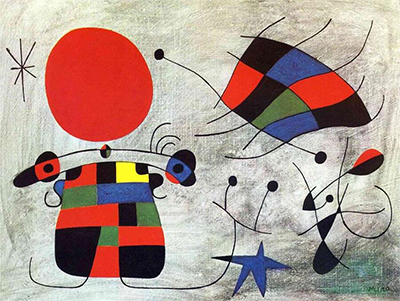The Smile of the Flamboyant Wings was known originally as The Smile of the Flamboyant Wings and was completed by Joan Miro in 1953. Today the item is display at the Museo Nacional Centro de Arte Reina Sofía which is based in Madrid, Spain.
Cave paintings and pre-historic art more generally are believed to have been the inspiration behind a series of paintings by Joan Miro, with this particular example being the first of those. We find many elements with which we are entirely familiar from his career, with bright red circles and strong lines of black paint or pen. He would often create grids of intersecting lines and then fill the central shapes that were formed from this with bright tones of colour, normally involving any of red, white, green or blue. We find similar here, though with also a single block of yellow that actually grabs one's attention fairly quickly due to its uniqueness. Black blocks and lines would help to bring out the alternative colours as best as possible and he often used this technique of a smoky or wishy-washy background which felt organic and unplanned, but also avoided distracting from the main focal point of the piece.
The artist often liked to produce stars from lines which meet in the middle and these would offer an alternative to the large blocks of paint found elsewhere. Colour was therefore an important element to Miro's abstract art, as reality and form were being left behind as he created new worlds in which items were much harder to understand. Others who mastered all the uses of colour during this period would be Klee and Kandinsky, both of whom wrote about the topic in depth. Quite simply, as artists in the 20th century sought to reduce detail in their paintings, this then created a far greater importance on the other elements of their style, with choosing the right complementary colours being an essential choice to make correctly.
The Museo Nacional Centro de Arte Reina Sofía has an impressive selection of art but has to compete against other major galleries elsewhere in the city of Madrid. The highlight to be found here is, without doubt, Guernica by Pablo Picasso, which itself is one of the most famous paintings of the 20th century, from any artist or movement. They also have a number of Salvador Dali paintings here as well, as well as a good selection of Cubist paintings from Spanish and French artists with whom many are already familiar. One might spend more time in the likes of the Prado Museum, but this institution should not be overlooked and also houses its collection within some stunning architecture, which can be considered an attraction in its own right.




